Analysis of Chemical Composition Characteristics and Source of PM2.5 under Different Pollution Degrees in Autumn and Winter of Liaocheng, China
Abstract
:1. Introduction
2. Materials and Methods
2.1. Sampling of PM2.5
2.1.1. Sampling Position, Period and Samples Collection
2.1.2. Quality Assurance and Quality Control of Sampling
2.2. Chemical Components Analysis of PM2.5
2.2.1. Water-Soluble Ions
2.2.2. Carbonaceous Species
2.2.3. Inorganic Element
2.2.4. Quality Assurance and Quality Control of Chemical Components Analysis
2.3. Data Analysis Method
2.3.1. Online Data Source
2.3.2. Analysis of Secondary Pollution
2.3.3. Positive Matrix Factorization Analysis
2.3.4. Back Trajectory and Clustering Analysis
3. Results and Discussion
3.1. Analysis of Mass Concentrations of PM2.5 and the Meteorological Conditions
3.2. Analysis of Chemical Components
3.2.1. Water Soluble Ions Analysis
3.2.2. OC and EC Analysis
3.2.3. Elemental Analysis
3.3. PM2.5 Mass Reconstruction
3.4. Source Apportionment of PM2.5
3.4.1. Source Apportionment of PM2.5 Using PMF
3.4.2. Source Analysis of PM2.5 Using Back Trajectory and Clustering
4. Conclusions
- (1)
- During the study period, the concentration of PM2.5 varied from 26.7 to 286.3 μg/m3, with an average concentration of 109.7 ± 56.8 μg/m3 in autumn and winter in Liaocheng, which was 0.46 times higher than the limit value of PM2.5 concentration CAAQS (GB 3095-2012) (daily standard: 75 μg/m3). Number of pollution days accounted for 67.6% of sampling period.
- (2)
- The concentration of water-soluble ions, OC, EC and elements were 50.47, 15.2, 6.66, 12.21 μg/m3 and accounted for 46.0%,13.9%,6.1% and 11.1% of PM2.5 concentrations, respectively. SNA were the main component of water-soluble ions and accounted for 84.7%, while the concentration of SOC was 8.01 μg/m3 and accounted for 52.7% of OC.
- (3)
- The concentrations of water-soluble ions, OC, EC and elements were 19.85, 10.22, 4.43, 11.81 μg/m3, 47.32, 15.45, 6.65 and 12.32 μg/m3, 110.29, 22.93, 10.45 and 12.60 μg/m3 at CLD, MMD and SSD, respectively. With the increase of pollution degree, the concentration of water-soluble ions and carbon components increased significantly, while the concentration of inorganic elements only increased slightly.
- (4)
- The results of chemical composition reconstruction showed that SNA and OM accounted for a higher proportion of PM2.5, which were 39.0% and 22.2%, respectively. The proportion of crustal substances, other ions, EC and trace elements were relatively low, 15.9%, 7.0%, 6.1% and 2.1%, respectively. The proportion of SNA increased significantly with the increase of pollution degree, from 23.0% at CLD to 49.0% at SSD. The proportion of other components decreased, especially crustal materials.
- (5)
- Five factors of PM2.5 have been identified by PMF: secondary transformation sources (36.7%), combustion-related sources (20.4%), SOA (11.7%), vehicle emissions (11%), dust (10.5%) and industrial processes (9.7%). The contribution of secondary inorganic sources, which was the main cause of the PM2.5 concentration rise, reached 57% in SSD.
- (6)
- During the study period, the air mass mainly came from five paths in Liaocheng, and the air mass from the Shandong province and the northeast accounted for a higher proportion. The secondary transformation contribution of the air mass with short transmission distance like that in clusters 1, 2 and 3 were higher, while the contribution of the dust from the long distance, like clusters 4 and 5, were higher.
Author Contributions
Funding
Institutional Review Board Statement
Informed Consent Statement
Data Availability Statement
Acknowledgments
Conflicts of Interest
References
- Circular of the State Council on Printing and Distributing the Action Plan for the Prevention and Control of Air Pollution. Available online: http://www.gov.cn/zwgk/2013-09/12/content_2486773.htm (accessed on 12 September 2013).
- Circular of the State Council on Printing and Distributing the Three-Year Action Plan for Winning the Battle against Blue Sky. Available online: http://www.gov.cn/zhengce/content/2018-07/03/content_5303158.htm (accessed on 27 June 2018).
- China Ecological and Environmental Status Bulletin. 2019. Available online: http://www.mee.gov.cn/hjzl/sthjzk/zghjzkgb/202006/P020200602509464172096.pdf (accessed on 2 June 2020).
- Dao, X.; Ji, D.S.; Zhang, X.; Zhang, X.; Tang, G.G.; Liu, Y.; Wang, L.L.; Cheng, L.J.; Wang, Y.S. Characteristics of chemical composition of PM2.5 in Beijing-Tianjin-Hebei and its surrounding areas during the heating period. Res. Environ. Sci. 2021, 34, 1–10. [Google Scholar]
- Li, L.; An, J.Y.; Zhou, M.; Qiao, L.P.; Zhu, S.H.; Yan, R.S.; Ooi, C.G.; Wang, H.L.; Huang, C.; Huang, L. An integrated source apportionment methodology and its application over the Yangtze River Delta region, China. Environ. Sci. Technol. 2018, 26, 14216–14227. [Google Scholar] [CrossRef] [PubMed]
- Yu, G.H.; Su, C.P.; Cao, L.M.; Wang, C.; Huang, X.F. Source apportionment of organic matter in atmospheric PM2.5 of a typical light-industrial zone in the Pearl River Delta. Environ. Sci. Technol. 2020, 43, 155–162. [Google Scholar]
- Wen, W.; He, X.D.; Ma, X.; Wei, P.; Cheng, S.Y.; Wang, X.Q.; Liu, L. Understanding the regional transport contributions of primary and secondary PM2.5 components over Beijing during a severe pollution episode. Aerosol Air Qual. Res. 2018, 18, 1720–1733. [Google Scholar] [CrossRef] [Green Version]
- Ding, J.; Zhang, Y.F.; Zhao, P.S.; Xiao, Z.M.; Zhang, W.H.; Zhang, H.T.; Yu, Z.J.; Du, X.; Li, L.W.; Yuan, J. Comparison of size-resolved hygroscopic growth factors of urban aerosol by different methods in Tianjin during a haze episode. Sci. Total. Environ. 2019, 678, 618–626. [Google Scholar] [CrossRef]
- Guan, Y.N.; Zhang, B.X.; Ni, S.Y.; Wang, H.H.; Lu, J.J.; Han, J.; Zhao, Y.G.; Duan, E.H.; Hou, L.A. Relationship between atmospheric visibility and particulate matter pollution in addition to relative humidity in Shijiazhuang. J. Saf. Environ. 2020, 20, 2001–2008. [Google Scholar]
- Wang, S.B.; Wang, H.; Zhang, J.Q.; Li, H.; Wu, Y.J.; Liu, R.Z.; Wang, S.L. Characterization analysis of PM2.5 and water-soluble ions during autumn in Xingtai City. China Environ. Sci. 2020, 40, 1877–1884. [Google Scholar]
- Yang, L.X.; Wang, D.C.; Cheng, S.H.; Wang, Z.; Zhou, Y.; Zhou, X.H.; Wang, W.X. Influence of meteorological conditions and particulate matter on visual range impairment in Jinan, China. Sci. Total. Environ. 2007, 383, 164–173. [Google Scholar] [CrossRef] [PubMed]
- Qiao, L.P.; Cai, J.; Wang, H.L.; Wang, W.B.; Zhou, M.; Lou, S.R.; Chen, R.J.; Dai, H.X.; Chen, C.H.; Kan, H.D. PM2.5 constituents and hospital emergency-room visits in Shanghai, China. Environ. Sci. Technol. 2014, 48, 10406–10414. [Google Scholar] [CrossRef]
- Guo, Z.Y.; Yang, Y.X.; Peng, L.; Lian, X.F.; Fu, Y.Z.; Zhang, G.H.; Bi, X.H.; Wang, X.M. The size-resolved light absorption contribution of water soluble organic carbon in the atmosphere of Guangzhou. China Environ. Sci. 2021, 41, 497–504. [Google Scholar]
- Liu, B.S.; Bi, X.H.; Feng, Y.C.; Dai, Q.L.; Xiao, Z.M.; Li, L.W.; Wu, J.H.; Yuan, J.; Zhang, Y.F. Fine carbonaceous aerosol characteristics at a megacity during the Chinese Spring Festival as given by OC EC online measurements. Atmos. Res. 2016, 181, 20–28. [Google Scholar] [CrossRef]
- Costa, D.L.; Dreher, K.L. Bioavailable transition metals in particulate matter mediate cardiopulmonary injury in healthy and compromised animal models. Environ. Health Perspect. 1997, 105, 1053–1060. [Google Scholar] [PubMed] [Green Version]
- Zhu, T.; Feng, Y.C. Atmospheric Particulate Matter Source Analysis; Science Press: Beijing, China, 2012; pp. 8–9. [Google Scholar]
- Zhang, J.Q.; Wu, Y.J.; Zhang, M.; Wang, H.; Chen, Z.X.; Hu, J.; Li, H.; Fan, X.L.; Chai, F.H.; Wang, S.L. PM2.5 pollution characterization and cause analysis of a winter heavy pollution event, Liaocheng city. Environ. Sci. 2018, 39, 4026–4033. [Google Scholar]
- Yi, Y.N.; Hou, Z.F.; Meng, J.J.; Yan, L.; Wang, X.P.; Liu, X.D.; Fu, M.X.; Wei, B.J. Diurnal variations and source analysis of water-soluble compounds in PM2.5 during the winter in Liaocheng city. Environ. Sci. 2019, 40, 4319–4329. [Google Scholar]
- Zhang, J.Q.; Luo, D.T.; Wang, S.B.; Wang, H.; Hu, W.Z.; Li, H.; Liu, R.Z.; Wang, S.L. Characterization and source analysis of PM2.5 and water-soluble ions during winter in Liaocheng city. Res. Environ. Sci. 2018, 31, 1712–1718. [Google Scholar]
- Charles, L.B.; Philip, M.R.; Shelley, J.T.; Steve, D.Z.; John, H.S. The use of ambient measurements to identify which precursor species limit aerosol nitrate formation. J. Air Waste Manag. Assoc. 2011, 50, 2073–2084. [Google Scholar]
- Ambient Air-Determination of the Water Soluble Anions (F−, Cl−, Br−, NO2−, NO3−, PO43−, SO32−, SO42−) from Atmospheric Paticles-Ion Chromatography. Available online: http://www.mee.gov.cn/ywgz/fgbz/bz/bzwb/jcffbz/201605/t20160519_337906.shtml (accessed on 13 May 2016).
- Ambient Air-Determination of the Water Soluble Cations (Li+, Na+, NH4+, K+, Ca2+, Mg2+) from Atmospheric Particles-Ion Chromatography. Available online: http://www.mee.gov.cn/ywgz/fgbz/bz/bzwb/jcffbz/201605/t20160519_337907.shtml (accessed on 13 May 2016).
- Willeke, K.; Baron, P.A. Aerosol Measurement: Principles, Techniques and Applications; Van Nostrand Reinhold: New York, NY, USA, 1993; p. 249. [Google Scholar]
- Guide to Source Analysis and Monitoring of Ambient Air Particlate Matter. Available online: http://www.mee.gov.cn/xxgk2018/xxgk/sthjbsh/202005/W020200514318605389760.pdf (accessed on 1 May 2020).
- Chow, J.C.; Watson, J.G.; Pritchett, L.C.; Pierson, W.R.; Frazier, C.A.; Purcell, R.G. The dri thermal optical reflectance carbon analysis system–Description, evaluation and applications in United-States air-quality studies. Atmos. Environ. Part A Gen. Top. 1993, 27, 1185–1201. [Google Scholar] [CrossRef]
- Chow, J.C.; Watson, J.G.; Chen, L.W.A.; Paredes, M.G.; Chang, M.C.O.; Trimble, D.; Fung, K.K.; Zhang, H.; Zhen, Y.J. Refining temperature measures in thermal/optical carbon analysis. Atmos. Chem. Phys. 2005, 5, 2961–2972. [Google Scholar] [CrossRef] [Green Version]
- Chow, J.C.; Watson, J.G.; Chen, L.W.A.; Oliver, M.C.; Norman, F.C.; Dana, R.; Steven, K.t. The IMPROVE-A temperature protocol for thermal/optical carbon analysis: Maintaining consistency with a long-term database. J. Air Waste Manag. 2007, 57, 1014–1023. [Google Scholar] [CrossRef] [Green Version]
- Ambient Air and Waste Gas From Stationary Sources Emission-Determination of Metal Elements in Ambient Particle Matter-Inductively Coupled Plasma Optical Emission Spectrometry. Available online: http://www.mee.gov.cn/ywgz/fgbz/bz/bzwb/jcffbz/201512/t20151214_319107.shtml (accessed on 1 January 2016).
- Ambient Air and Stationary Source Emission-Determination of Metals in Ambient Particulat Matter Inductively Coupled Plasma/Mass Spectrometry(ICP-MS). Available online: http://www.mee.gov.cn/ywgz/fgbz/bz/bzwb/jcffbz/201308/t20130820_257714.shtml (accessed on 16 August 2013).
- Karthikeyan, S.; Balasubramanian, R. Inter laboratory study to improve the quality of trace element determinations in rainwater. Anal. Chim. Acta 2006, 576, 9–16. [Google Scholar] [CrossRef]
- Karthikeyan, S.; Joshi, U.M.; Balasubramanian, R. Rapid sample preparation using microwave for evaluation of bioavailability of trace elements in urban airborne particulate matter. Anal. Chim. Acta 2006, 576, 23–30. [Google Scholar] [CrossRef]
- Yao, X.H.; Chan, C.K.; Fang, M.; Cadle, S.; Chan, T.; Mulawa, P.; He, K.B.; Ye, B.M. The water-soluble ionic composition of PM2.5 in Shanghai and Beijing, China. Atmos. Environ. 2002, 4223–4234. [Google Scholar] [CrossRef]
- Zhang, Y.L.; Jun, L.; Gan, Z. Radiocarbon-based source apportionment of carbonaceous aerosols at a regional background site on Hainan Island, South China. Environ. Sci. Technol. 2014, 48, 2651–2659. [Google Scholar] [CrossRef]
- Chen, Y.; Zhi, G.; Feng, Y.; Fu, J.; Feng, J.; Sheng, G.; Simoneit, B.R.T. Measurements of emission factors for primary carbonaceous particles from residential raw-coal combustion in China. Geophys. Res. Lett. 2006, 33, 382–385. [Google Scholar] [CrossRef]
- Zheng, M.; Zhang, Y.J.; Yan, C.Q.; Zhu, X.L.; Schauer, J.J.; Zhang, Y.H. Review of PM2.5 source apportionment methods in China. Acta Sci. Nat. Univ. Pekin. 2014, 50, 1141–1154. [Google Scholar]
- US EPA. PMF 5.0 User Guide [EB/OL]. Available online: https://www.epa.gov/air-research/epa-positive-matrix-factorization-50-fundamentals-and-user-guide. (accessed on 10 April 2021).
- Zhao, Q.; Li, X.R.; Wang, G.X.; Zhang, L.; Yang, Y.; Liu, S.Q.; Sun, N.N.; Huang, Y.; Lei, W.K.; Liu, X.G. Chemical composition and source analysis of PM2.5 in Yuncheng, Shanxi province in autumn and winter. Environ. Sci. 2021, 42, 1626–1635. [Google Scholar]
- Wang, H.; Wang, S.L.; Zhang, J.Q.; Li, H. Characteristics of PM2.5 pollution with comparative analysis of O3 in Autumn–Winter Seasons of Xingtai, China. Atmosphere 2021, 12, 569. [Google Scholar] [CrossRef]
- Xu, R.; Zhang, H.D.; Yang, X.W.; Cheng, S.Y.; Zhang, T.H.; Jiang, Q. Concentration characteristics of PM2.5 and the causes of heavy air pollution events in Beijing during autumn and winter. Environ. Sci. 2019, 40, 3405–3414. [Google Scholar]
- Lei, T.Y.; Zhang, Y.; Gao, Y.G.; Li, G.; Wang, W.; Miao, Y.G.; Ren, L.H. Chemical characteristics of water-soluble ions of PM2.5 in autumn and winter in Heze city. Res. Environ. Sci. 2020, 33, 831–840. [Google Scholar]
- Chen, C.; Wang, T.J.; Li, Y.H.; Ma, H.L.; Chen, P.L.; Wang, D.Y.; Zhang, Y.X.; Qiao, Q.; Li, G.M.; Wang, W.H. Pollution characteristics and source apportionment of fine particulate matter in autumn and winter in Puyang, China. Environ. Sci. 2019, 40, 3421–3430. [Google Scholar]
- Miao, Q.Q.; Jiang, N.; Zhang, R.Q.; Zhao, X.N.; Qi, W.J. Characteristics and sources of PM2.5 pollutions in typical cities of the central plains Urban Agglomeration in autumn and winter. Environ. Sci. 2021, 42, 19–29. [Google Scholar]
- Liu, H.J.; Zhao, C.S.; Nekat, B.; Ma, N.; Wiedensohler, A.; Pinxteren, D.V.; Spindler, G.; Muller, K.; Herrmann, H. Aerosol hygroscopicity derived from size-segregated chemical composition and its parameterization in the North China Plain. Atmos. Chem. Phys. 2014, 14, 2525–2539. [Google Scholar] [CrossRef] [Green Version]
- Number of Motor Vehicles of Liaocheng City. 2016. Available online: http://www.liaocheng.gov.cn/xxgk/szfbmxxgk/sgaj/201901/t20190121_1913323.html (accessed on 17 February 2017).
- Conference of Etc Promotion and Application. Available online: http://jtj.liaocheng.gov.cn/xwzx_13663/jtyw/201908/t20190812_2345636.html (accessed on 12 August 2019).
- The Number of Private Cars Surpassed 200 Million for the First Time in 66 Cities, China. Available online: https://www.mps.gov.cn/n7944517/n7944597/n7945888/c7478950/content.html (accessed on 8 January 2020).
- Naoki, K.; Hiroshi, Y.; Tateki, M.; Kazuhiko, S.; Mastaka, S. Chemical forms and sources of extremely high nitrate and chloride in winter aerosol pollution in the Kanto Plain of Japan. Atmos. Environ. 1999, 33, 1745–1756. [Google Scholar]
- Zong, Z.; Wang, X.P.; Tian, C.G.; Chen, Y.J.; Qu, L.; Ji, L.; Zhi, G.R.; Li, J.; Zhang, G. Source apportionment of PM2.5 at a regional background site in North China using PMF linked with radiocarbon analysis: Insight into the contribution of biomass burning. Atmos. Chem. Phys. 2016, 16, 11249–11265. [Google Scholar] [CrossRef] [Green Version]
- Andreae, M.O. Soot carbon and excess fine potassium: Long-range transport of combustion-derived aerosols. Science 1983, 220, 1148–1151. [Google Scholar] [CrossRef] [PubMed]
- Lestari, P.; Mauliadi, Y.D. Source apportionment of particulate matter at urban mixed site in Indonesia using PMF. Atmos. Environ. 2009, 43, 1760–1770. [Google Scholar] [CrossRef]
- Pachauri, T.; Singla, V.; Satsangi, A.; Lakhani, A.; Maharaj, K.K. Characterization of carbonaceous aerosols with special reference to episodic events at Agra, India. Atmos. Res. 2013, 128, 98–110. [Google Scholar] [CrossRef]
- Schauer, J.J.; Kleeman, M.J.; Cass, G.R.; Simoneit, B.R.T. Measurement of emissions from air pollution sources.2.C1 through C30 organic compounds from medium duty diesel trucks. Environ. Sci. Technol. 1999, 33, 1578–1587. [Google Scholar] [CrossRef]
- Schauer, J.J.; Kleeman, M.J.; Cass, G.R.; Simoneit, B.R.T. Measurement of emissions from air pollution sources: 3.C1-C29 organic compounds from fireplace combustion of wood. Environ. Sci. Technol. 2001, 35, 1716–1728. [Google Scholar] [CrossRef]
- Chow, J.C.; Watson, J.G.; Lu, Z.Q.; Lowenthal, D.H.; Frazier, C.A.; Solomon, P.A.; Thuillier, R.H.; Magliano, K. Descriptive analysis of PM2.5 and PM10 at regionally representative locations during Sjvaqs/Auspex. Atmos. Environ. 1996, 30, 2079–2112. [Google Scholar] [CrossRef]
- Gao, J.J.; Tian, H.Z.; Cheng, K.; Lu, L.; Zheng, M.; Wang, S.X.; Hao, J.M.; Wang, K.; Hua, S.B.; Zhu, C.Y. The variation of chemical characteristics of PM2.5 and PM10 and formation causes during two haze pollution events in urban Beijing, China. Atmos. Environ. 2015, 107, 1–8. [Google Scholar] [CrossRef]
- Zhang, F.; Wang, Z.W.; Cheng, H.R.; Lv, X.P.; Gong, W.; Wang, X.M.; Zhang, G. Seasonal variations and chemical characteristics of PM2.5 in Wuhan, central China. Sci. Total Environ. 2015, 518, 97–105. [Google Scholar] [CrossRef] [PubMed]
- Xing, L.; Fu, T.M.; Cao, J.J.; Lee, S.C.; Wang, G.H.; Ho, K.F.; Cheng, M.C.; You, C.F.; Wang, T.J. Seasonal and spatial variability of the OM/OC mass ratios and high regional correlation between oxalic acid and zinc in Chinese urban organic aerosols. Atmos. Chem. Phys. 2013, 13, 4307–4318. [Google Scholar] [CrossRef] [Green Version]
- Yang, F.M.; He, K.B.; Ma, Y.L.; Zhang, Q.; Cadle, S.H.; Chan, T.; Mulawa, P.A. Characterization of mass balance of PM2.5 chemical speciation in Beijing. Environ. Chem. 2004, 23, 326–333. [Google Scholar]
- Tursic, J.; Berner, A.; Podkrajsek, B.; Grgic, I. Influence of ammonia on sulfate formation under haze conditions. Atmos. Environ. 2004, 38, 2789–2795. [Google Scholar] [CrossRef]
- Tian, H.Z.; Wang, Y.; Xue, Z.G.; Cheng, K.; Qu, Y.P.; Chai, F.H.; Hao, J.M. Trend and characteristics of atmospheric emissions of Hg, As and Se from coal combustion in China,1980–2007. Atmos. Chem. Phys. 2010, 10, 11905–11919. [Google Scholar] [CrossRef] [Green Version]
- Tao, J.; Gao, J.; Zhang, L.M.; Zhang, R.J.; Che, H.Z.; Zhang, Z.S.; Lin, Z.; Jing, J.; Cao, J.J.; Hsu, S.C. PM2.5 pollutions in a megacity of southwest China: Source apportionment and implication. Atmos. Chem. Phys. 2014, 14, 8679–8699. [Google Scholar] [CrossRef] [Green Version]
- Duan, J.C.; Tan, J.H. Atmospheric heavy metals and Arsenic in China: Situation, sources and control policies. Atmos. Environ. 2014, 74, 93–101. [Google Scholar] [CrossRef]
- Watson, J.G.; Chow, J.C.; Houck, J.E. PM2.5 chemical source profiles for vehicle exhaust, vegetative burning, geological material, and coal burning in Northwestern Colorado during 1995. Chemosphere 2001, 43, 1141–1151. [Google Scholar] [CrossRef]
- Yu, L.D.; Wang, G.F.; Zhang, R.J.; Zhang, L.M.; Song, Y.; Wu, B.B.; Li, X.F.; An, K.; Chu, J.H. Characterization and source apportionment of PM2.5 in an urban environment in Beijing. Aerosol Air Qual. Res. 2013, 13, 574–583. [Google Scholar] [CrossRef] [Green Version]
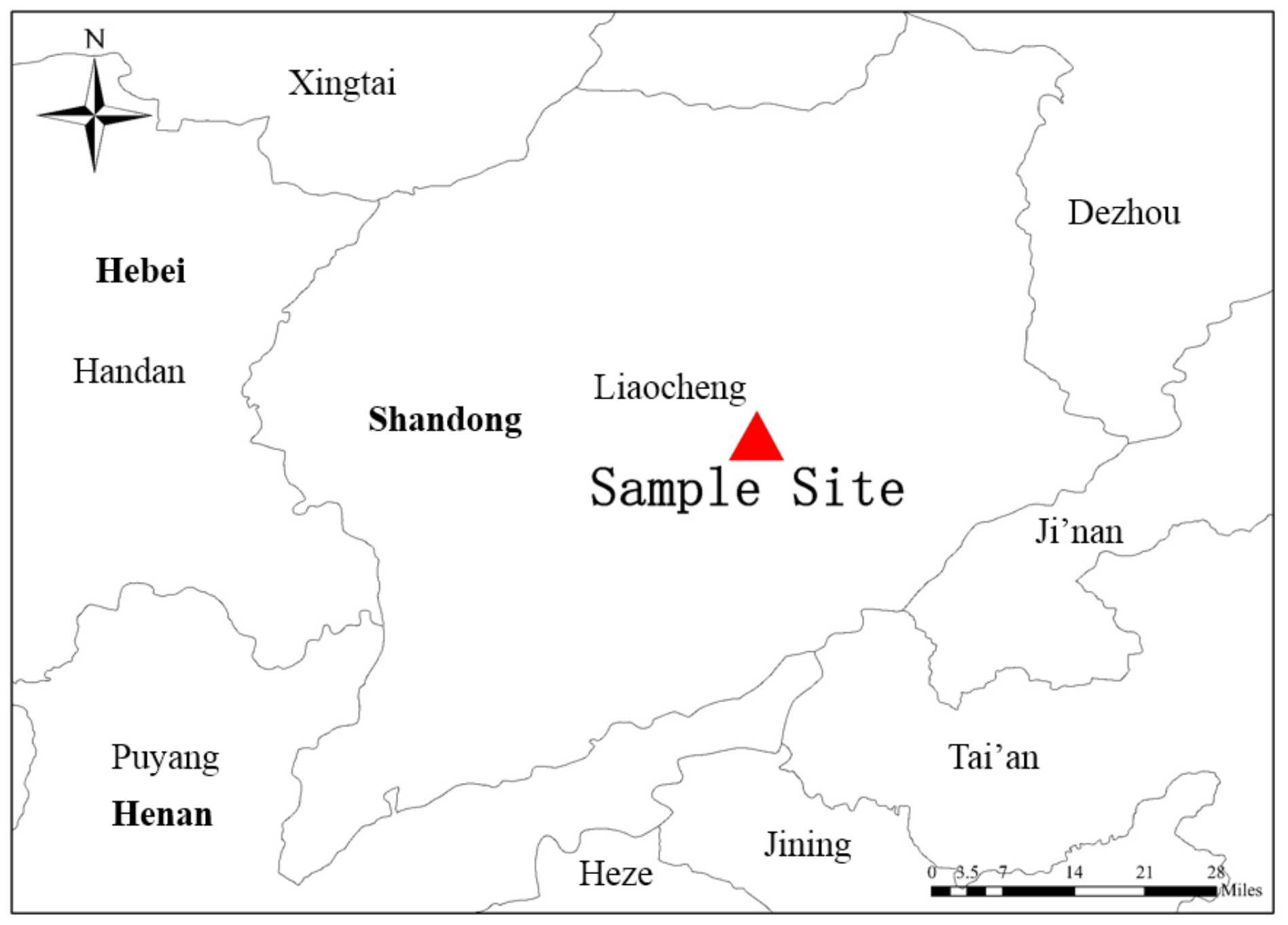
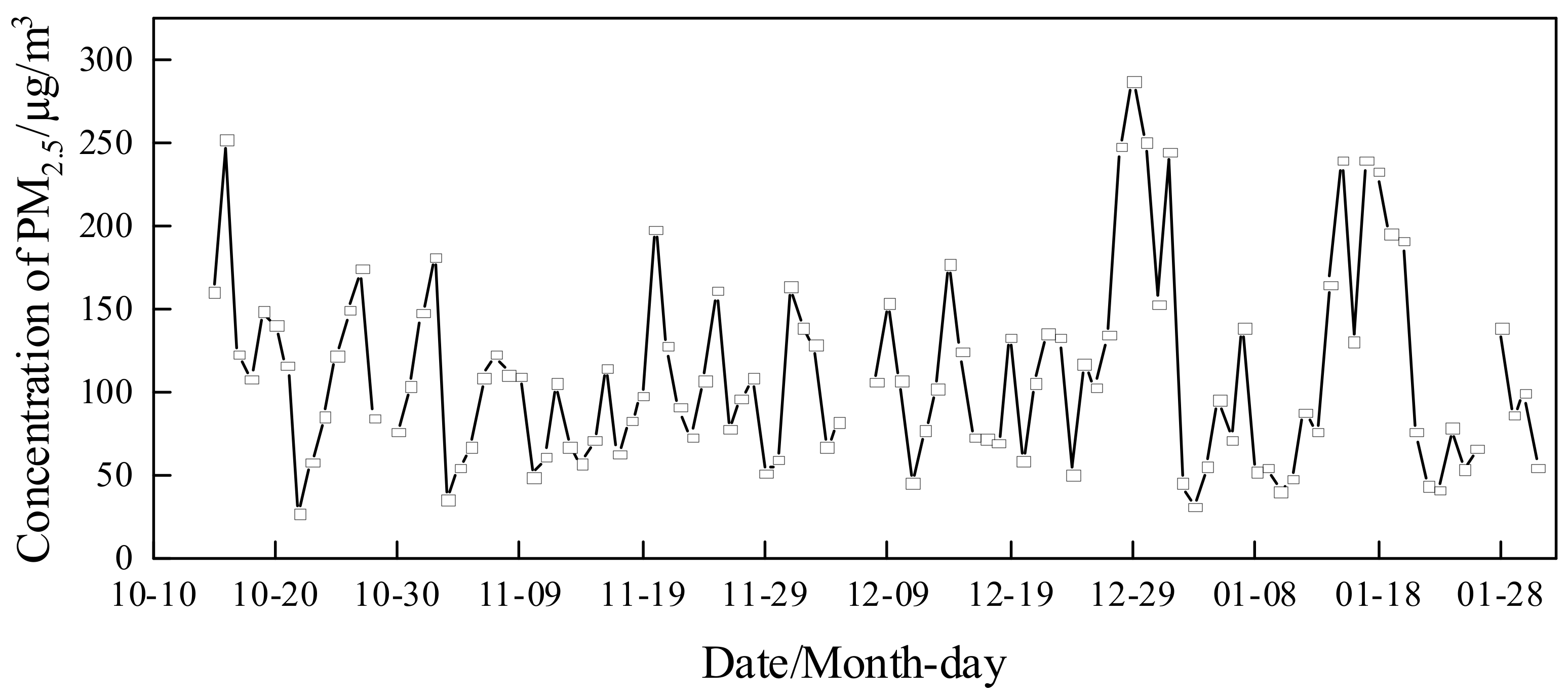
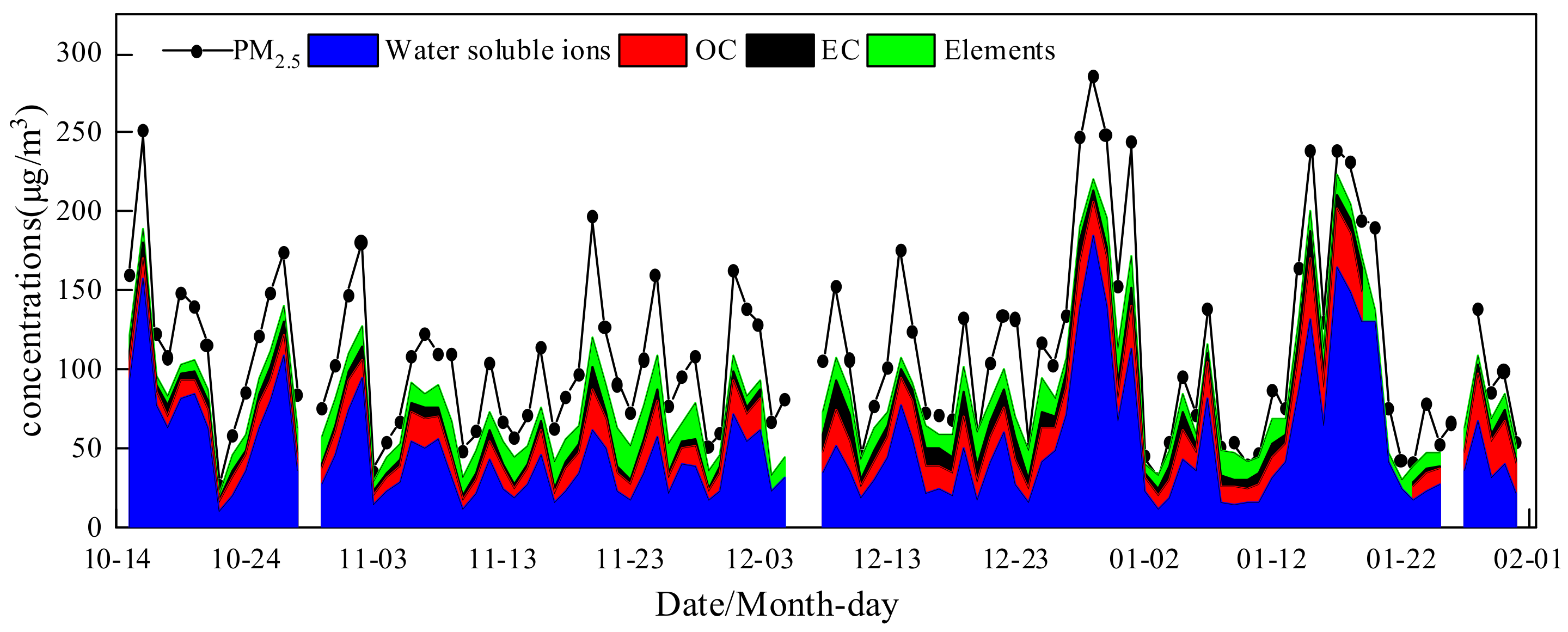

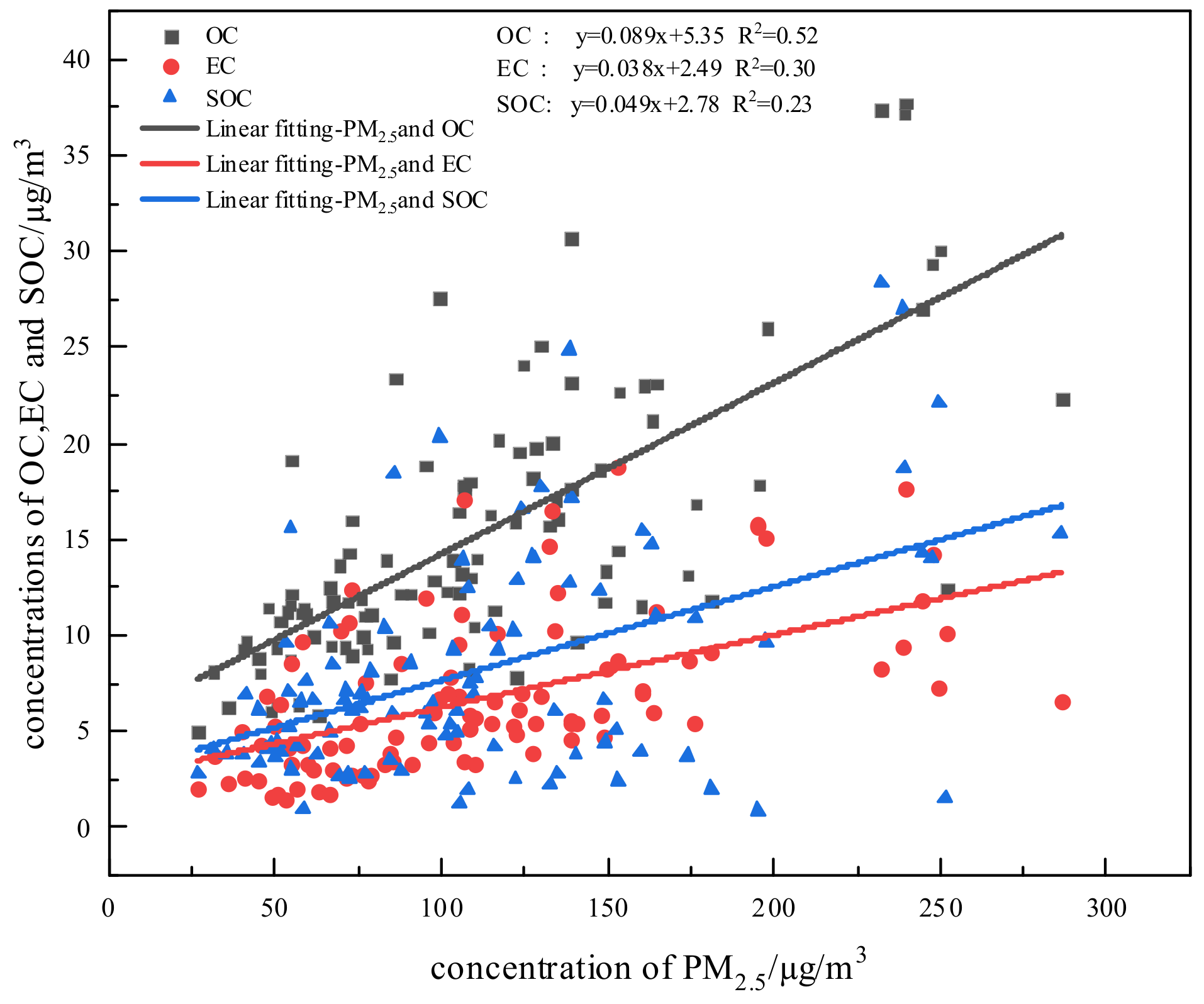
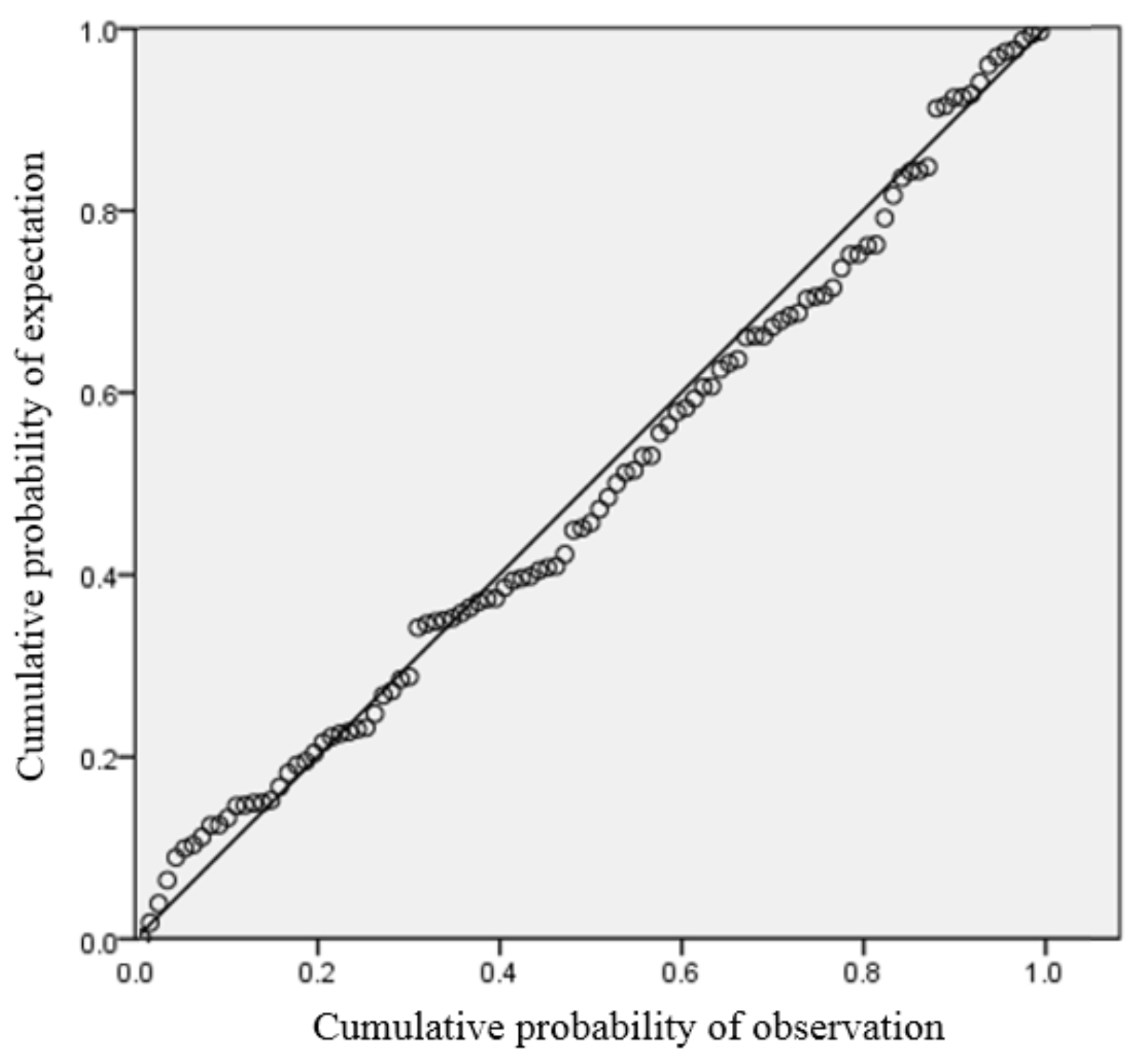
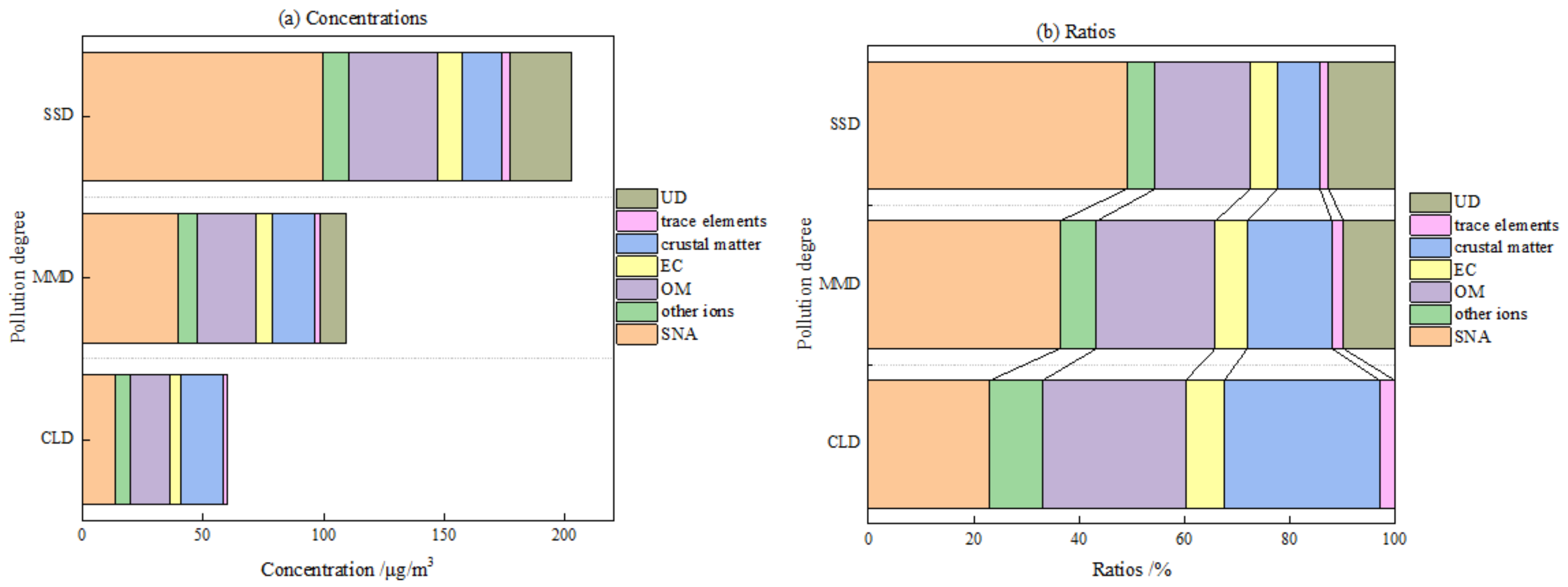
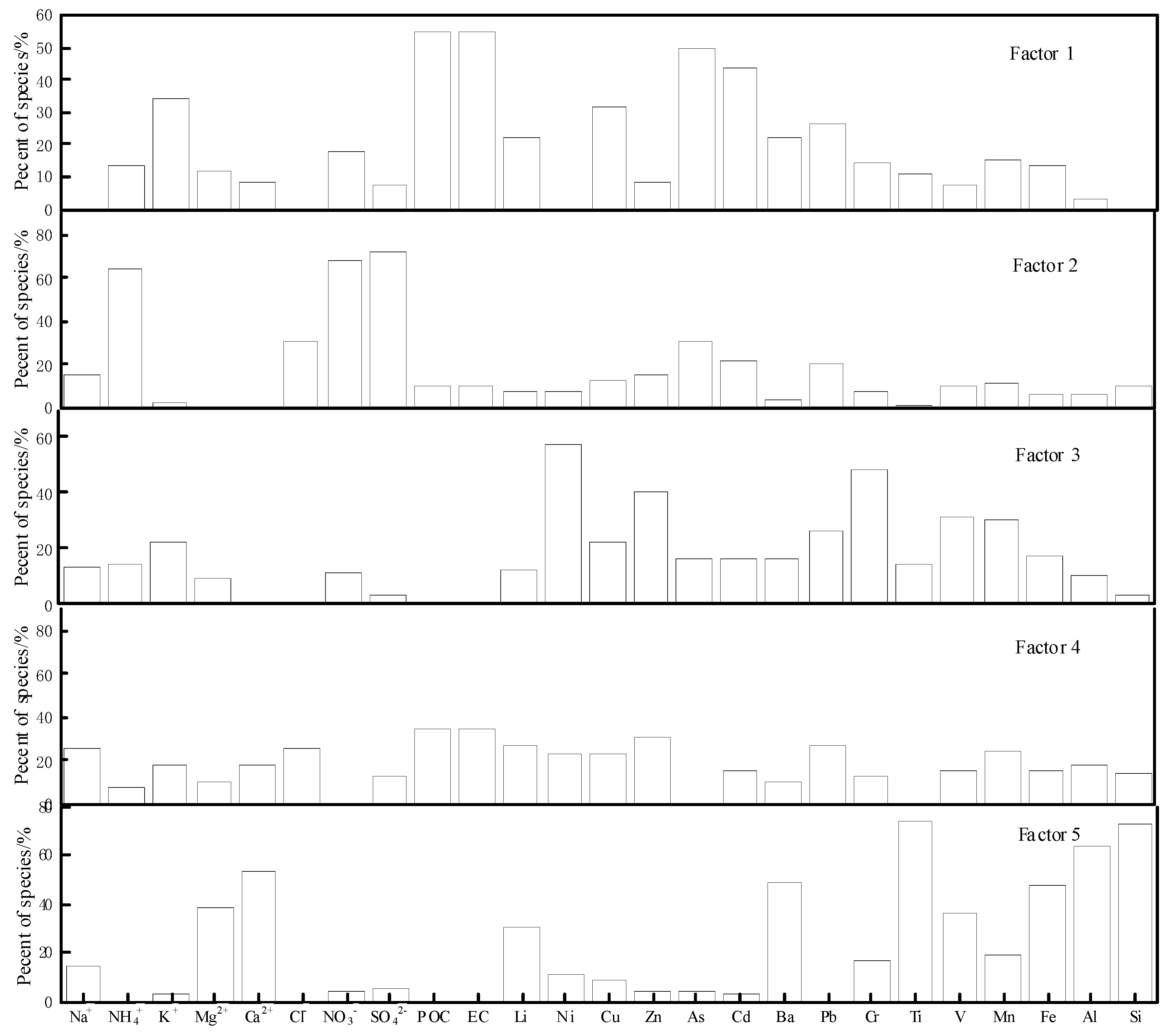
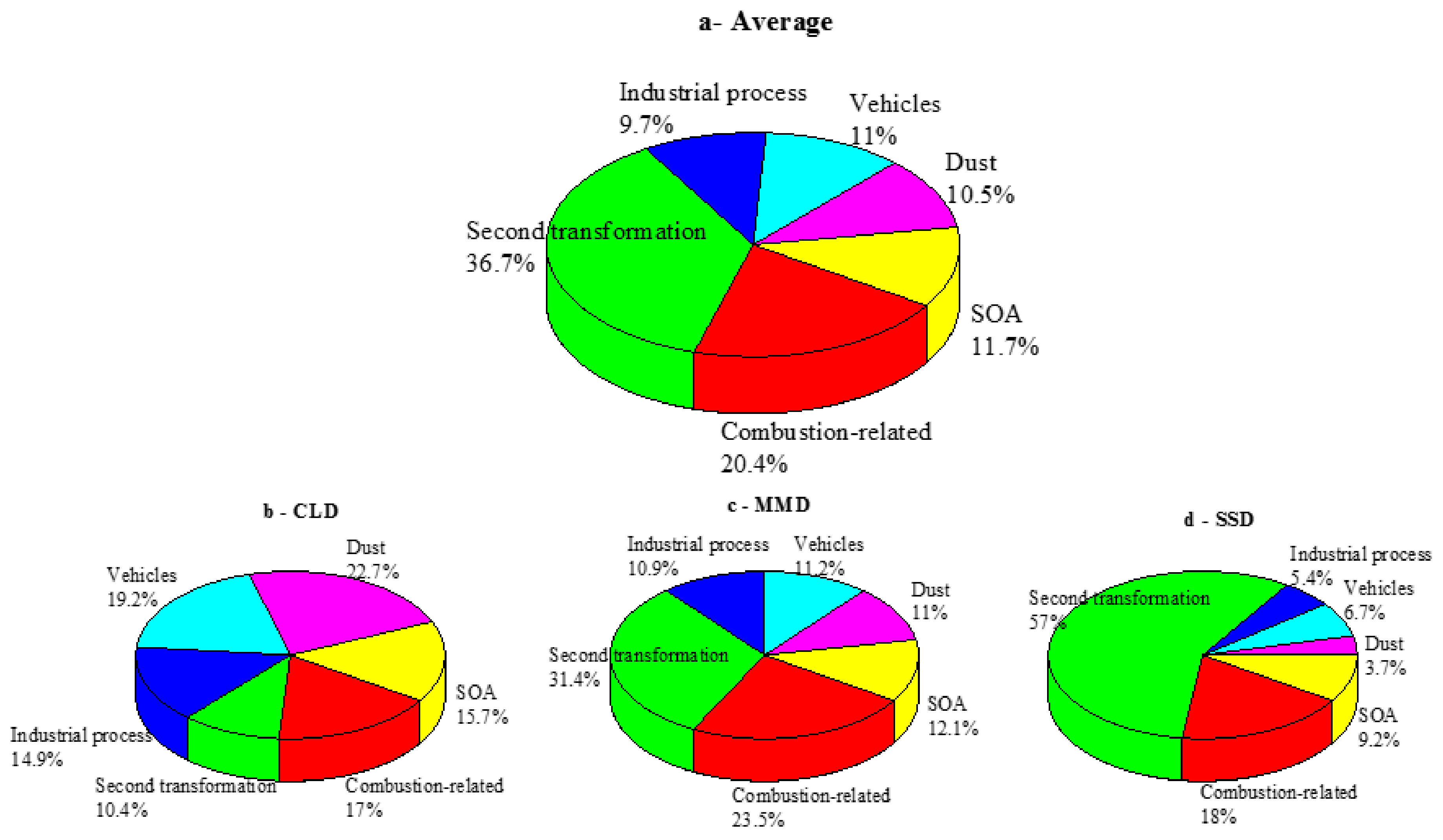
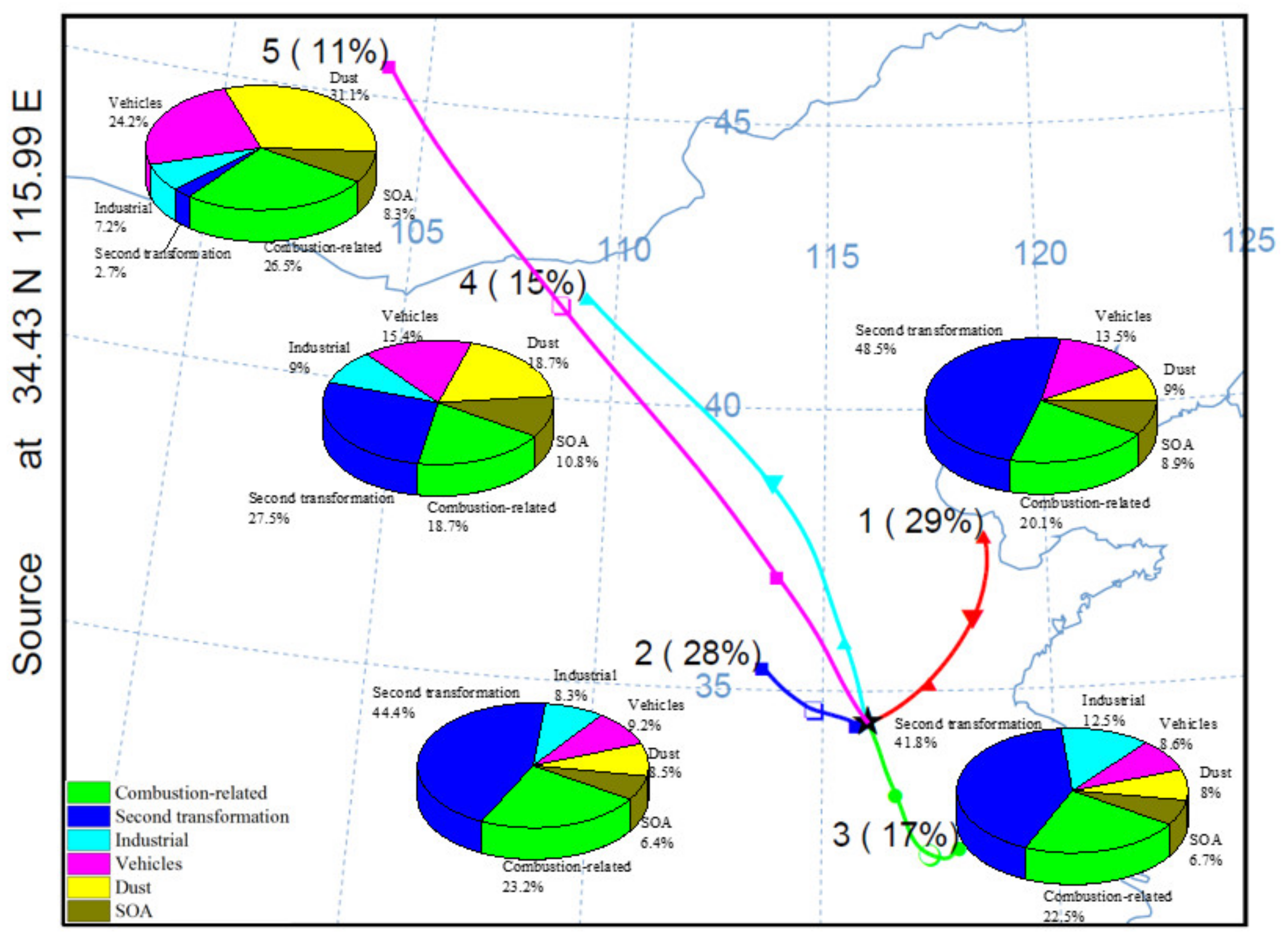
| Average | CLD | MMD | SSD | |
|---|---|---|---|---|
| Wind speed/m/s | 1.37 ± 0.41 | 1.44 ± 0.40 | 1.35 ± 0.41 | 1.33 ± 0.45 |
| Temperature/°C | 5.80 ± 6.22 | 3.96 ± 5.31 | 6.91 ± 6.75 | 6.00 ± 5.76 |
| RH/% | 44.15 ± 15.85 | 38.38 ± 14.57 | 44.19 ± 15.65 | 53.56 ± 14.42 |
| Air pressure/Pa | 1020.9 ± 5.1 | 1022.6 ± 5.2 | 1020.2 ± 5.2 | 1019.9 ± 4.2 |
| Components | Average Concentration | CLD | MMD | SSD | |
|---|---|---|---|---|---|
| μg/m3 | |||||
| PM2.5 | 109.7 ± 56.8 | 55.2 ± 12.3 | 109.5 ± 21.8 | 202.8 ± 41.5 | |
| water soluble ions | Na+ | 0.41 ± 0.18 | 0.34 ± 0.10 | 0.40 ± 0.18 | 0.56 ± 0.19 |
| NH4+ | 9.40 ± 7.65 | 3.29 ± 1.59 | 9.03 ± 3.78 | 20.73 ± 8.70 | |
| K+ | 1.11 ± 0.46 | 0.78 ± 0.29 | 1.22 ± 0.39 | 1.40 ± 0.52 | |
| Mg2+ | 0.14 ± 0.06 | 0.14 ± 0.06 | 0.15 ± 0.07 | 0.13 ± 0.07 | |
| Ca2+ | 2.10 ± 1.12 | 2.20 ± 1.10 | 2.13 ± 1.15 | 1.83 ± 1.10 | |
| F− | 0.11 ± 0.08 | 0.10 ± 0.07 | 0.11 ± 0.09 | 0.11 ± 0.10 | |
| Cl− | 3.85 ± 2.58 | 2.46 ± 1.06 | 3.59 ± 1.96 | 6.87 ± 3.33 | |
| NO3− | 22.40 ± 19.44 | 6.64 ± 3.34 | 21.47 ± 10.75 | 51.56 ± 20.08 | |
| SO42− | 10.96 ± 10.88 | 3.93 ± 1.90 | 9.28 ± 5.20 | 27.19 ± 14.05 | |
| SUM-IC | 50.42 ± 37.91 | 19.85 ± 6.11 | 47.32 ± 17.24 | 110.29 ± 39.32 | |
| carbon | OC | 15.20 ± 7.02 | 10.22 ± 3.06 | 15.45 ± 5.23 | 22.93 ± 8.64 |
| EC | 6.66 ± 3.95 | 4.43 ± 2.94 | 6.65 ± 3.39 | 10.45 ± 4.04 | |
| SOC | 8.01 ± 5.95 | 5.43 ± 2.88 | 8.28 ± 5.56 | 11.65 ± 8.47 | |
| Elements | Li | 0.0019 ± 0.0008 | 0.0015 ± 0.0006 | 0.0019 ± 0.0007 | 0.0026 ± 0.0010 |
| Co | 0.0005 ± 0.0003 | 0.0004 ± 0.0002 | 0.0005 ± 0.0003 | 0.0005 ± 0.0003 | |
| Ni | 0.0057 ± 0.0048 | 0.0049 ± 0.0033 | 0.0064 ± 0.0062 | 0.0054 ± 0.0020 | |
| Cu | 0.0455 ± 0.0201 | 0.0338 ± 0.0157 | 0.0482 ± 0.0190 | 0.0587 ± 0.0199 | |
| Zn | 0.2016 ± 0.0914 | 0.1779 ± 0.1083 | 0.1955 ± 0.0799 | 0.2572 ± 0.0647 | |
| As | 0.0094 ± 0.0067 | 0.0041 ± 0.0021 | 0.0100 ± 0.0059 | 0.0171 ± 0.0054 | |
| Cd | 0.0025 ± 0.0017 | 0.0011 ± 0.0005 | 0.0028 ± 0.0016 | 0.0039 ± 0.0016 | |
| Sn | 0.0065 ± 0.0036 | 0.0044 ± 0.0030 | 0.0070 ± 0.0037 | 0.0090 ± 0.0025 | |
| Sb | 0.0060 ± 0.0034 | 0.0038 ± 0.0031 | 0.0060 ± 0.0026 | 0.0096 ± 0.0028 | |
| Ba | 0.0202 ± 0.0091 | 0.0181 ± 0.0085 | 0.0211 ± 0.0082 | 0.0214 ± 0.0117 | |
| Pb | 0.0734 ± 0.0400 | 0.0443 ± 0.0220 | 0.0753 ± 0.0336 | 0.1177 ± 0.0367 | |
| Na | 0.5020 ± 0.2301 | 0.4332 ± 0.1728 | 0.4861 ± 0.2448 | 0.6594 ± 0.2122 | |
| K | 1.4711 ± 0.6047 | 0.9903 ± 0.3168 | 1.5093 ± 0.4183 | 2.1913 ± 0.6347 | |
| Cr | 0.0102 ± 0.0055 | 0.0079 ± 0.0038 | 0.0109 ± 0.0056 | 0.0124 ± 0.0064 | |
| Ti | 0.0728 ± 0.0403 | 0.0775 ± 0.0383 | 0.0723 ± 0.0422 | 0.0657 ± 0.0395 | |
| V | 0.0030 ± 0.0014 | 0.0024 ± 0.0009 | 0.0031 ± 0.0014 | 0.0039 ± 0.0016 | |
| Mn | 0.0608 ± 0.0243 | 0.0496 ± 0.0195 | 0.0622 ± 0.0249 | 0.0764 ± 0.0212 | |
| Fe | 1.1028 ± 0.4868 | 1.0034 ± 0.4605 | 1.1247 ± 0.4838 | 1.2161 ± 0.5298 | |
| Mg | 0.3494 ± 0.1835 | 0.3693 ± 0.1744 | 0.3488 ± 0.1884 | 0.3172 ± 0.1904 | |
| Ca | 2.7409 ± 1.3701 | 2.9749 ± 1.2922 | 2.7356 ± 1.3917 | 2.3566 ± 1.4228 | |
| Al | 1.5279 ± 0.7900 | 1.5258 ± 0.6556 | 1.5946 ± 0.9102 | 1.3611 ± 0.6694 | |
| Si | 3.9964 ± 2.0354 | 4.0806 ± 1.9460 | 4.0023 ± 2.1081 | 3.8380 ± 2.0894 | |
| SUM | 12.21 ± 4.84 | 11.81 ± 4.47 | 12.32 ± 5.05 | 12.60 ± 5.11 | |
Publisher’s Note: MDPI stays neutral with regard to jurisdictional claims in published maps and institutional affiliations. |
© 2021 by the authors. Licensee MDPI, Basel, Switzerland. This article is an open access article distributed under the terms and conditions of the Creative Commons Attribution (CC BY) license (https://creativecommons.org/licenses/by/4.0/).
Share and Cite
Zhang, J.; Wang, H.; Yan, L.; Ding, W.; Liu, R.; Wang, H.; Wang, S. Analysis of Chemical Composition Characteristics and Source of PM2.5 under Different Pollution Degrees in Autumn and Winter of Liaocheng, China. Atmosphere 2021, 12, 1180. https://doi.org/10.3390/atmos12091180
Zhang J, Wang H, Yan L, Ding W, Liu R, Wang H, Wang S. Analysis of Chemical Composition Characteristics and Source of PM2.5 under Different Pollution Degrees in Autumn and Winter of Liaocheng, China. Atmosphere. 2021; 12(9):1180. https://doi.org/10.3390/atmos12091180
Chicago/Turabian StyleZhang, Jingqiao, Han Wang, Li Yan, Wenwen Ding, Ruize Liu, Hongliang Wang, and Shulan Wang. 2021. "Analysis of Chemical Composition Characteristics and Source of PM2.5 under Different Pollution Degrees in Autumn and Winter of Liaocheng, China" Atmosphere 12, no. 9: 1180. https://doi.org/10.3390/atmos12091180
APA StyleZhang, J., Wang, H., Yan, L., Ding, W., Liu, R., Wang, H., & Wang, S. (2021). Analysis of Chemical Composition Characteristics and Source of PM2.5 under Different Pollution Degrees in Autumn and Winter of Liaocheng, China. Atmosphere, 12(9), 1180. https://doi.org/10.3390/atmos12091180





